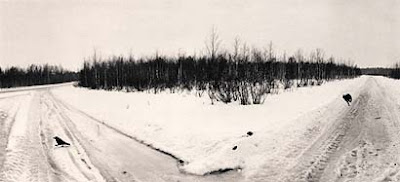 |
| Hal'mg-tangch, Kalmykia, Pentti Sammallahti |
The ceiling of the bedroom is painted a faded sky blue. There are two large rusty hooks screwed into the beams and from these, long ago, the farmer hung his smoked sausages and hams. This is the room in which I’m writing. Outside the window are old plum trees, the fruit now turning raven blue, and beyond them the nearest hill which forms the first step to the mountains.
Early this morning, when I was still in bed, a swallow flew in, circled the room, saw its error and flew out through the window past the plum trees to alight on the telephone wire. I relate this small incident because it seems to me to have something to do with Pentti Sammallahti’s photographs. They too, like the swallow, are – aberrant.
I have had these photographs in the house now during two years. I often take them out of their folder to show to friends who pass. They usually gasp at first, and then peer closer, smiling. They look at the places shown for a longer time than is usual with a photograph. Perhaps they ask whether I know Sam- mallahti personally? Or what part of Russia were they taken in? In what year? They never try to put their evident pleasure into words, for it is the secret one. They simply look closer and remember. What?
In each of the pictures there is at least one dog. That’s clear and it might be no more than a gimmick. In fact the dogs offer a key for opening a door. No, a gate – for here everything is outside, out side and beyond. Boundless.
 |
| White Sea, Russia, 1992, Pentti Sammallahti |
Notice also the special light, the light determined by the time of day or the season of the year. It is, invariably, the light in which figures hunt – for animals, forgotten names, a path leading home, a new day, sleep, the next lorry, spring. A light in which there is no permanence, a light nothing longer than a glimpse. This too is a key to opening the gate.
The photos were taken with the panoramic camera, such as is normally used for making wide-section geological surveys. Here the wide-section is important, not, I think, for aesthetic reasons but again for scientific, observational ones. A lens with narrower focus would not have found what we can now see, and so it would have remained invisible. What exactly?
 |
| Medvez'egorsk, Karelia, Pentti Sammallahti |
Children know it and so do nomads. Yet neither nomads nor children write such things down. So I have to invent cumbersome phrases which have little to do with boundless land. Not even the dogs can help me. Not yet.
We live our daily lives in a constant exhange with the set of daily appearances surrounding us – often they are very familiar, sometimes they are unexpected and new, but always they confirm us in our lives. They do so even when they are threatening: the sight of a house burning, for example, or a man approach- ing us with a knife between his teeth, still reminds us (ungently) of our life and its importance. What we habitually see confirms us.
Yet it can happen, suddenly, unexpectedly, and most frequently in the half-light of glimpses, that we catch sight of another visible order which intersects with ours and has nothing to do with it.
 |
| Solovki, White Sea, Russia, 1992, Pentti Sammallahti |
The speed of a cinema film is 24 frames per second. God knows how many frames per second flicker past our daily perception. But it is as if at the brief moments I’m talking about, suddenly and disconcert- ingly we se between two frames. We come upon a part of the visible which wasn’t destined for us. Perhaps it was destined for — night-birds, reindeer, ferrets, eels, whales... Perhaps it was destined not only for ani- mals but for lakes, slow-growing trees, ores, carbon...Our customary visible order is not the only one: it co-exists with other orders. Stories of fairies, sprites, ogres were a human attempt to come to terms with this co-existence. Hunters are continually aware of it and so can read signs we do not see. Children feel it intuitively, because they have the habit of hiding behind things. There they discover the interstices between different sets of the visible.
Knock! Knock! Who’s there? Guess who!
Probably it was a dog who led Sammallahti to the moment and place for taking of each picture. In each one the human order, still in sight, is nevertheless no longer central and is slipping away. The inter- stices are open.
The result is unsettling for those who are not nomads. There is more solitude, more pain, more der- eliction. At the same time, there is an expectancy which we have not experienced since childhood, since we talked to the dogs, listened their secret and kept it to ourselves.
 | |
| Paanajarvi, Karelia, Russia, 1992, Pentti Sammallahti |

Here is one of the links for his photography
ReplyDeletehttp://www.photoeye.com/gallery/forms2/index.cfm?image=1&id=68149&imagePosition=1&Door=2&Portfolio=Portfolio1&Gallery=2&Page=
Thanks Hilary for this link
ReplyDeletehttp://www.finlit.fi/booksfromfinland/bff/398/berger.htm